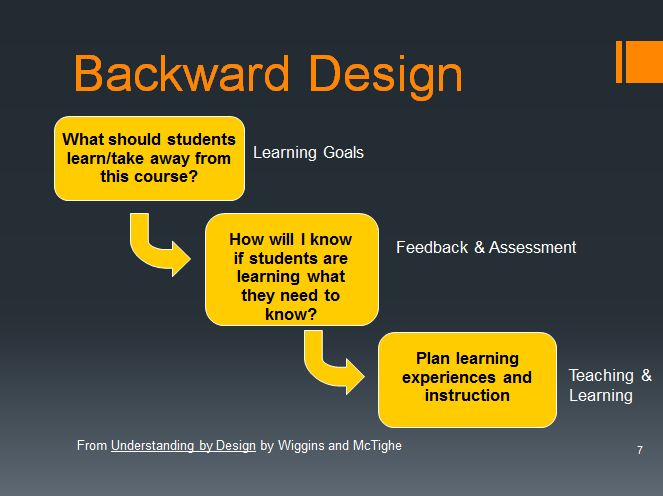Newly Revised CFT Guide on Course Design
 The Understanding by Design teaching guide was recently updated by Ryan Bowen, a graduate teaching fellow at the Center for Teaching. Understanding by Design is a book written by Grant Wiggins and Jay McTighe that offers a framework for designing courses, content units, and lessons. The teaching guide walks readers through “backward design” which is one of the primary design approaches mentioned in Understanding by Design. The guide explores the benefits of using backward design as compared to traditional methods of instructional planning, and then it elaborates on the three stages of the process as established by Wiggins and McTighe. Finally, the guide offers a planning template for readers to engage with the backward design process. Blank templates can be downloaded alongside a model template that is complete with descriptions to ensure clarity of what is being asked at each stage.
The Understanding by Design teaching guide was recently updated by Ryan Bowen, a graduate teaching fellow at the Center for Teaching. Understanding by Design is a book written by Grant Wiggins and Jay McTighe that offers a framework for designing courses, content units, and lessons. The teaching guide walks readers through “backward design” which is one of the primary design approaches mentioned in Understanding by Design. The guide explores the benefits of using backward design as compared to traditional methods of instructional planning, and then it elaborates on the three stages of the process as established by Wiggins and McTighe. Finally, the guide offers a planning template for readers to engage with the backward design process. Blank templates can be downloaded alongside a model template that is complete with descriptions to ensure clarity of what is being asked at each stage.
The teaching guide begins by contrasting backward design and the traditional ‘forward design’ approach to planning instruction. It then seeks to provide resources and steps on how an instructor can use backward design when planning their courses, units, and lessons.
The information provided in the guide was utilized to facilitate a Course Design workshop in April 2017 where graduate students and post-docs were given the opportunity to practice designing courses, units, and lessons using backward design. The guide was also leveraged for the Course Design Institute, a multi-day workshop for faculty at Vanderbilt.
The CFT encourages the use of backward design in planning instruction whether it is an entire course, a unit, or an individual lesson. Aside from being utilized in workshops, backward design is also embedded in the curriculum of other programs at the CFT including the Certificate in College Teaching (CiCT). Therefore, this teaching guide will act as a platform for participants in the CiCT (and other programs) when they are practicing lesson planning.
The hope is that the teaching guide acts as a walkthrough for instructors on how to utilize backward design. Experience has shown that this design approach is powerful for student learning and course, unit, and lesson organization.

Leave a Response